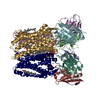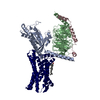+ データを開く
データを開く
- 基本情報
基本情報
| 登録情報 | データベース: PDB / ID: 8u4n | ||||||
|---|---|---|---|---|---|---|---|
| タイトル | Structure of Apo CXCR4/Gi complex | ||||||
 要素 要素 |
| ||||||
 キーワード キーワード | SIGNALING PROTEIN / GPCR / chemokine receptor | ||||||
| 機能・相同性 |  機能・相同性情報 機能・相同性情報C-X-C motif chemokine 12 receptor activity / regulation of viral process / positive regulation of vascular wound healing / positive regulation of macrophage migration inhibitory factor signaling pathway / positive regulation of mesenchymal stem cell migration / neuron recognition / response to ultrasound / telencephalon cell migration / C-X-C chemokine receptor activity / response to tacrolimus ...C-X-C motif chemokine 12 receptor activity / regulation of viral process / positive regulation of vascular wound healing / positive regulation of macrophage migration inhibitory factor signaling pathway / positive regulation of mesenchymal stem cell migration / neuron recognition / response to ultrasound / telencephalon cell migration / C-X-C chemokine receptor activity / response to tacrolimus / Specification of primordial germ cells / CXCL12-activated CXCR4 signaling pathway / myosin light chain binding / myelin maintenance / positive regulation of vasculature development / regulation of programmed cell death / endothelial tube morphogenesis / endothelial cell differentiation / C-C chemokine receptor activity / Signaling by ROBO receptors / regulation of chemotaxis / : / C-C chemokine binding / positive regulation of chemotaxis / positive regulation of dendrite extension / Formation of definitive endoderm / Chemokine receptors bind chemokines / anchoring junction / dendritic cell chemotaxis / positive regulation of oligodendrocyte differentiation / small molecule binding / epithelial cell development / cell leading edge / cellular response to cytokine stimulus / detection of temperature stimulus involved in sensory perception of pain / regulation of calcium ion transport / T cell migration / detection of mechanical stimulus involved in sensory perception of pain / D2 dopamine receptor binding / Binding and entry of HIV virion / Adenylate cyclase inhibitory pathway / positive regulation of protein localization to cell cortex / regulation of cell adhesion / regulation of cAMP-mediated signaling / coreceptor activity / G protein-coupled serotonin receptor binding / cardiac muscle contraction / cellular response to forskolin / regulation of mitotic spindle organization / adenylate cyclase-inhibiting G protein-coupled receptor signaling pathway / neurogenesis / G-protein beta/gamma-subunit complex binding / cell chemotaxis / ubiquitin binding / response to activity / Regulation of insulin secretion / G protein-coupled receptor binding / G protein-coupled receptor activity / calcium-mediated signaling / brain development / neuron migration / response to virus / adenylate cyclase-modulating G protein-coupled receptor signaling pathway / Olfactory Signaling Pathway / Activation of the phototransduction cascade / Prostacyclin signalling through prostacyclin receptor / G beta:gamma signalling through PLC beta / Presynaptic function of Kainate receptors / Thromboxane signalling through TP receptor / Glucagon signaling in metabolic regulation / G protein-coupled acetylcholine receptor signaling pathway / G-protein activation / Activation of G protein gated Potassium channels / Inhibition of voltage gated Ca2+ channels via Gbeta/gamma subunits / G beta:gamma signalling through CDC42 / response to peptide hormone / Vasopressin regulates renal water homeostasis via Aquaporins / G beta:gamma signalling through BTK / ADP signalling through P2Y purinoceptor 12 / Synthesis, secretion, and inactivation of Glucagon-like Peptide-1 (GLP-1) / Glucagon-type ligand receptors / Sensory perception of sweet, bitter, and umami (glutamate) taste / photoreceptor disc membrane / G alpha (z) signalling events / Adrenaline,noradrenaline inhibits insulin secretion / Glucagon-like Peptide-1 (GLP1) regulates insulin secretion / ADORA2B mediated anti-inflammatory cytokines production / cellular response to catecholamine stimulus / sensory perception of taste / ADP signalling through P2Y purinoceptor 1 / adenylate cyclase-activating dopamine receptor signaling pathway / G beta:gamma signalling through PI3Kgamma / GPER1 signaling / Cooperation of PDCL (PhLP1) and TRiC/CCT in G-protein beta folding / GDP binding / cellular response to prostaglandin E stimulus / Inactivation, recovery and regulation of the phototransduction cascade / G-protein beta-subunit binding / heterotrimeric G-protein complex / positive regulation of cold-induced thermogenesis 類似検索 - 分子機能 | ||||||
| 生物種 |  Homo sapiens (ヒト) Homo sapiens (ヒト) | ||||||
| 手法 | 電子顕微鏡法 / 単粒子再構成法 / クライオ電子顕微鏡法 / 解像度: 2.72 Å | ||||||
 データ登録者 データ登録者 | Saotome, K. / McGoldrick, L.L. / Franklin, M.C. | ||||||
| 資金援助 |  米国, 1件 米国, 1件
| ||||||
 引用 引用 |  ジャーナル: Nat Struct Mol Biol / 年: 2024 ジャーナル: Nat Struct Mol Biol / 年: 2024タイトル: Structural insights into CXCR4 modulation and oligomerization. 著者: Kei Saotome / Luke L McGoldrick / Jo-Hao Ho / Trudy F Ramlall / Sweta Shah / Michael J Moore / Jee Hae Kim / Raymond Leidich / William C Olson / Matthew C Franklin /  要旨: Activation of the chemokine receptor CXCR4 by its chemokine ligand CXCL12 regulates diverse cellular processes. Previously reported crystal structures of CXCR4 revealed the architecture of an ...Activation of the chemokine receptor CXCR4 by its chemokine ligand CXCL12 regulates diverse cellular processes. Previously reported crystal structures of CXCR4 revealed the architecture of an inactive, homodimeric receptor. However, many structural aspects of CXCR4 remain poorly understood. Here, we use cryo-electron microscopy to investigate various modes of human CXCR4 regulation. CXCL12 activates CXCR4 by inserting its N terminus deep into the CXCR4 orthosteric pocket. The binding of US Food and Drug Administration-approved antagonist AMD3100 is stabilized by electrostatic interactions with acidic residues in the seven-transmembrane-helix bundle. A potent antibody blocker, REGN7663, binds across the extracellular face of CXCR4 and inserts its complementarity-determining region H3 loop into the orthosteric pocket. Trimeric and tetrameric structures of CXCR4 reveal modes of G-protein-coupled receptor oligomerization. We show that CXCR4 adopts distinct subunit conformations in trimeric and tetrameric assemblies, highlighting how oligomerization could allosterically regulate chemokine receptor function. #1:  ジャーナル: Biorxiv / 年: 2024 ジャーナル: Biorxiv / 年: 2024タイトル: Structural insights into CXCR4 modulation and oligomerization 著者: Saotome, K. / McGoldrick, L.L. / Ho, J. / Ramlall, T. / Shah, S. / Moore, M.J. / Kim, J.H. / Leidich, R. / Olson, W.C. / Franklin, M.C. | ||||||
| 履歴 |
|
- 構造の表示
構造の表示
| 構造ビューア | 分子:  Molmil Molmil Jmol/JSmol Jmol/JSmol |
|---|
- ダウンロードとリンク
ダウンロードとリンク
- ダウンロード
ダウンロード
| PDBx/mmCIF形式 |  8u4n.cif.gz 8u4n.cif.gz | 202.2 KB | 表示 |  PDBx/mmCIF形式 PDBx/mmCIF形式 |
|---|---|---|---|---|
| PDB形式 |  pdb8u4n.ent.gz pdb8u4n.ent.gz | 144.2 KB | 表示 |  PDB形式 PDB形式 |
| PDBx/mmJSON形式 |  8u4n.json.gz 8u4n.json.gz | ツリー表示 |  PDBx/mmJSON形式 PDBx/mmJSON形式 | |
| その他 |  その他のダウンロード その他のダウンロード |
-検証レポート
| 文書・要旨 |  8u4n_validation.pdf.gz 8u4n_validation.pdf.gz | 1.6 MB | 表示 |  wwPDB検証レポート wwPDB検証レポート |
|---|---|---|---|---|
| 文書・詳細版 |  8u4n_full_validation.pdf.gz 8u4n_full_validation.pdf.gz | 1.6 MB | 表示 | |
| XML形式データ |  8u4n_validation.xml.gz 8u4n_validation.xml.gz | 37.2 KB | 表示 | |
| CIF形式データ |  8u4n_validation.cif.gz 8u4n_validation.cif.gz | 53.9 KB | 表示 | |
| アーカイブディレクトリ |  https://data.pdbj.org/pub/pdb/validation_reports/u4/8u4n https://data.pdbj.org/pub/pdb/validation_reports/u4/8u4n ftp://data.pdbj.org/pub/pdb/validation_reports/u4/8u4n ftp://data.pdbj.org/pub/pdb/validation_reports/u4/8u4n | HTTPS FTP |
-関連構造データ
| 関連構造データ |  41888MC  8u4oC  8u4pC  8u4qC  8u4rC  8u4sC  8u4tC M: このデータのモデリングに利用したマップデータ C: 同じ文献を引用 ( |
|---|---|
| 類似構造データ | 類似検索 - 機能・相同性  F&H 検索 F&H 検索 |
- リンク
リンク
- 集合体
集合体
| 登録構造単位 | 
|
|---|---|
| 1 |
|
- 要素
要素
| #1: タンパク質 | 分子量: 41591.312 Da / 分子数: 1 / 由来タイプ: 組換発現 / 由来: (組換発現)  Homo sapiens (ヒト) / 遺伝子: GNAI1 Homo sapiens (ヒト) / 遺伝子: GNAI1発現宿主:  参照: UniProt: P63096 |
|---|---|
| #2: タンパク質 | 分子量: 38534.062 Da / 分子数: 1 / 由来タイプ: 組換発現 / 由来: (組換発現)  Homo sapiens (ヒト) / 遺伝子: GNB1 Homo sapiens (ヒト) / 遺伝子: GNB1発現宿主:  参照: UniProt: P62873 |
| #3: タンパク質 | 分子量: 7861.143 Da / 分子数: 1 / 由来タイプ: 組換発現 / 由来: (組換発現)  Homo sapiens (ヒト) / 遺伝子: GNG2 Homo sapiens (ヒト) / 遺伝子: GNG2発現宿主:  参照: UniProt: P59768 |
| #4: タンパク質 | 分子量: 71063.609 Da / 分子数: 1 / 由来タイプ: 組換発現 / 由来: (組換発現)  Homo sapiens (ヒト) / 遺伝子: CXCR4 Homo sapiens (ヒト) / 遺伝子: CXCR4発現宿主:  参照: UniProt: P61073 |
| #5: 化合物 | ChemComp-CLR / |
| 研究の焦点であるリガンドがあるか | N |
-実験情報
-実験
| 実験 | 手法: 電子顕微鏡法 |
|---|---|
| EM実験 | 試料の集合状態: PARTICLE / 3次元再構成法: 単粒子再構成法 |
- 試料調製
試料調製
| 構成要素 | 名称: Apo CXCR4/Gi complex / タイプ: COMPLEX / Entity ID: #1-#4 / 由来: RECOMBINANT |
|---|---|
| 分子量 | 実験値: NO |
| 由来(天然) | 生物種:  Homo sapiens (ヒト) Homo sapiens (ヒト) |
| 由来(組換発現) | 生物種:  |
| 緩衝液 | pH: 7.5 |
| 試料 | 包埋: NO / シャドウイング: NO / 染色: NO / 凍結: YES |
| 急速凍結 | 凍結剤: ETHANE |
- 電子顕微鏡撮影
電子顕微鏡撮影
| 顕微鏡 | モデル: TFS GLACIOS |
|---|---|
| 電子銃 | 電子線源:  FIELD EMISSION GUN / 加速電圧: 200 kV / 照射モード: FLOOD BEAM FIELD EMISSION GUN / 加速電圧: 200 kV / 照射モード: FLOOD BEAM |
| 電子レンズ | モード: BRIGHT FIELD / 最大 デフォーカス(公称値): 2000 nm / 最小 デフォーカス(公称値): 1000 nm |
| 撮影 | 電子線照射量: 50 e/Å2 フィルム・検出器のモデル: TFS FALCON 4i (4k x 4k) |
- 解析
解析
| CTF補正 | タイプ: PHASE FLIPPING AND AMPLITUDE CORRECTION | ||||||||||||||||||||||||
|---|---|---|---|---|---|---|---|---|---|---|---|---|---|---|---|---|---|---|---|---|---|---|---|---|---|
| 3次元再構成 | 解像度: 2.72 Å / 解像度の算出法: FSC 0.143 CUT-OFF / 粒子像の数: 183399 / 対称性のタイプ: POINT | ||||||||||||||||||||||||
| 精密化 | 交差検証法: NONE 立体化学のターゲット値: GeoStd + Monomer Library + CDL v1.2 | ||||||||||||||||||||||||
| 原子変位パラメータ | Biso mean: 74.93 Å2 | ||||||||||||||||||||||||
| 拘束条件 |
|
 ムービー
ムービー コントローラー
コントローラー









 PDBj
PDBj





































